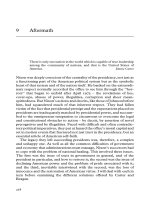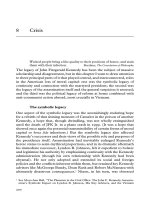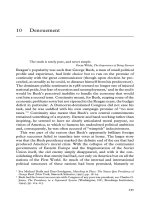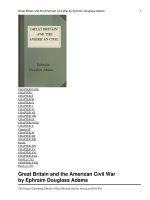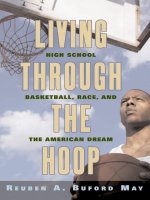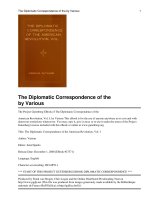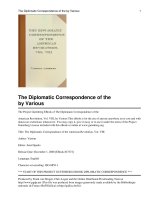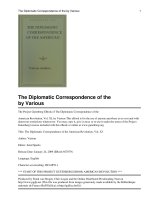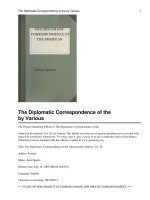5 2 5 paul revere and the american revolution
Bạn đang xem bản rút gọn của tài liệu. Xem và tải ngay bản đầy đủ của tài liệu tại đây (4.06 MB, 14 trang )
Suggested levels for Guided Reading, DRA,™
Lexile,® and Reading Recovery™ are provided
in the Pearson Scott Foresman Leveling Guide.
Paul Revere and the
American Revolution
By Patricia West
Genre
Narrative
nonfiction
Comprehension
Skills and Strategies
• Sequence
• Cause and Effect
• Ask Questions
Text Features
•
•
•
•
Captions
Call Outs
Map
Glossary
Scott Foresman Reading Street 5.2.5
ISBN 0-328-13530-5
ì<(sk$m)=bdfdab< +^-Ä-U-Ä-U
Reader Response
1. Here are some made-up newspaper headlines about
the events in this book. In what order might they have
been printed? Place them in the correct order using a
chart like the one below.
Paul
and the
A. Hooray
for TeaRevere
Parties
American
Revolution
B. Ungrateful
Colonists Refuse
to Share Costs of
French and Indian War
Patricia
C. Brave Revere MakesBy
Daring
Ride toWest
Warn Citizens
2. Do you have questions that were not answered by this
selection? Where could you look for the answers?
3. Think about the words in the Glossary and their
meanings. Write a paragraph using the seven words.
Remember that a paragraph has one main idea and
details that tell about the idea. Your paragraph may
be serious or silly.
4. What can you learn about a British soldier’s uniform
from the call outs on page 10?
Editorial Offices: Glenview, Illinois • Parsippany, New Jersey • New York, New York
Sales Offices: Needham, Massachusetts • Duluth, Georgia • Glenview, Illinois
Coppell, Texas • Ontario, California • Mesa, Arizona
Paul Revere had a secret. He spent some of his
time working as a skillful craftsman, making and
repairing all kinds of metal household items. He
also worked as a sort of dentist, replacing people’s
missing teeth with animal teeth. But it was Revere’s
somewhat secret third role as a member of the
Boston Sons of Liberty that won him a place in
United States history.
Paul Revere lived in this house from
1770 to 1800. It is Boston’s oldest
wooden building.
Every effort has been made to secure permission and provide appropriate credit for
photographic material. The publisher deeply regrets any omission and pledges to
correct errors called to its attention in subsequent editions.
Unless otherwise acknowledged, all photographs are the property of Scott Foresman,
a division of Pearson Education.
Photo locators denoted as follows: Top (T), Center (C), Bottom (B), Left (L), Right (R),
Background (Bkgd)
Opener: Library of Congress; 1 Corbis; 3 ©DK Images; 4 Library of Congress; 5 The
Granger Collection, NY; 6 Bettmann/Corbis; 7 Library of Congress; 8 Library of
Congress; 9 Corbis; 10 Getty Images; 11 Corbis; 12 Library of Congress; 13 Library of
Congress; 14 Library of Congress; 15 ©DK Images; 16 Library of Congress; 17 Robert
Holmes/Corbis; 18 Library of Congress; 20 Library of Congress; 21 Library of Congress;
22 ©DK Images; 23 ©DK Images
ISBN: 0-328-13530-5
Copyright © Pearson Education, Inc.
All Rights Reserved. Printed in the United States of America. This publication is
protected by Copyright, and permission should be obtained from the publisher
prior to any prohibited reproduction, storage in a retrieval system, or transmission
in any form by any means, electronic, mechanical, photocopying, recording, or
likewise. For information regarding permission(s), write to: Permissions Department,
Scott Foresman, 1900 East Lake Avenue, Glenview, Illinois 60025.
2 3 4 5 6 7 8 9 10 V0G1 14 13 12 11 10 09 08 07 06 05
3
Sons of Liberty
Paul Revere became famous for the part he
played in the Boston Sons of Liberty. This group
met often to discuss their complaints about the
British, whose king, King George III, ruled thirteen
colonies along the east coast of what is today the
United States. The meetings sometimes took place
under an elm tree the group called a “liberty tree.”
Nearly every town in colonial America had its own
liberty tree, where colonists gathered for anti-British
activities. Colonists posted their complaints about
British rule on its branches. Towns that did not have
a suitable tree put up a “liberty pole” instead.
Paul Revere created this engraving of a liberty tree obelisk.
4
Revere had once been a soldier who fought
for the British. He was among the colonists who
battled the French and their Native American allies
during the French and Indian War (1754–1763).
In that conflict the French lost the land they held
west of the Mississippi River. The British knew that
this territory would be too expensive to defend, so
they made a law that prevented the colonists from
settling west of the Appalachian Mountains. This law
made the colonists angry because many wanted to
move westward from the thirteen colonies.
5
The British went ahead and taxed the colonies
anyway. One law, passed in 1764, was called the
Sugar Act. It taxed sugar, molasses, and other
products shipped to the colonies. Colonists who
ignored the act were punished as smugglers.
A year later, the Stamp Act was passed by the
British. This law required all legal and business
documents in the colonies to carry a stamp showing
that a tax had been paid. Even newspapers had
to have this special stamp. The colonists were
very angry. They wondered what tax the British
would decide on next. Would the British try to tax
everything the colonists owned? It didn’t seem fair
because the colonists had no voice in the British
government. They claimed the British were taxing
them without representation.
King George III was the ruler of Britain, the thirteen American
colonies, and other British colonies around the world. He ruled
from 1760 to 1820, longer than any other British king.
The British were angry too, but for a different
reason. The war had put them deeply in debt. They
thought the colonists should help pay for the cost of
the war. After all, the war had been fought partly to
protect the colonies. But the colonists did not share
this view. The British also wanted the colonists to
help pay for the costs of defense and government.
This demand was no more popular than the first one.
6
The British government sold stamps that were required for
many documents, including newspapers. Colonists expressed
their anger by burning stamped papers. They also placed a
skull and crossbones image on documents that required a
British stamp.
7
The Colonists Boycott
The main purpose of the Boston Sons of Liberty
was to protest these British decisions. Many of the
colonists joined together to boycott, or refuse to buy,
any British goods. British merchants, seeing that their
businesses would be hurt by the boycott, thought the
act was a mistake. Even some British politicians agreed
with the colonists, and the act was soon cancelled.
Then the British government came up with
another way of raising money from the colonists. The
Townshend Acts taxed goods that were brought into
the colonies. Colonists would have to pay taxes when
they bought imported items such as glass, paper,
paint, lead, and tea. To make sure the taxes were
paid, British soldiers had the right to search colonists’
businesses and homes. In response to these actions,
another boycott of British goods was called for by
Samuel Adams, another member of the Boston Sons
of Liberty.
Imported glass and other goods were taxed.
8
Although women didn’t have much voice in
politics in those days, some of them formed a group
called Daughters of Liberty. By refusing to buy British
goods, these women made the hard work in their
homes even more difficult. They had to make the
items needed by their families themselves.
Leaders in the colonies encouraged peaceful
protests. However, people couldn’t always stay calm
while British troops were seizing their goods. When
Britain threatened to send more soldiers, Samuel
Adams declared, “We will destroy every soldier that
dares put his foot on shore.” Another thousand
soldiers landed in Boston in 1768 anyway. Tensions
increased between the soldiers and the colonists.
Both sides lost their manners. The soldiers bumped
Bostonians off the sidewalk and disrupted the
colonists’ church services with loud music. Younger
colonists yelled insults at the soldiers and called them
“lobsters.” That rude name arose because of the
bright red coats the British soldiers wore.
9
A British Soldier
The bright red
wool coat shrank in
the rain and made
movement difficult.
The tall, heavy hat
had to be fastened
to the soldier’s hair
or it would fall off.
Trouble in the Snow
Arguments between British soldiers and colonists
got worse and worse. They finally turned violent on
March 5, 1770. On that date, bystanders watched
British troops tread the streets of Boston. Colonists
threw a few snowballs and even stones. Angry words
were shouted. In all the confusion a British soldier
thought he heard his captain yell “Fire!” Before
the captain could stop his men, they fired, and five
Bostonians lay dead. Among them was an African
American sailor named Crispus Attucks. He was
the first person to die in what would become the
American Revolution.
The
musket
needed
reloading
after each
shot.
White pants were
hard to keep clean.
Square-toed shoes
were identical: there
was no difference
between the left and
right shoes.
10
11
Colonists React
Paul Revere used his talent to let people in all
the colonies know about this shocking event, which
became known as the Boston Massacre. He made an
engraving of the shooting, and many people saw it.
Revere’s engraving was not quite accurate, however.
His picture made it look as though the British
attacked the colonists on purpose. In reality, the
soldiers may have fired because they were frightened
and confused.
Paul Revere made this engraving and
sent it everywhere in the colonies.
12
The Boston Massacre
was followed by a trial
of the British soldiers.
The question was
whether the British
captain had ordered
his soldiers to fire. Two
witnesses claimed that
the order came from “a
person in dark-colored
clothing” who stood
John Adams was a patriot,
behind the troops. The
but he defended the British
jury decided that most
soldiers in their trial after
of the British soldiers
the Boston Massacre.
had acted in
self-defense.
By coincidence the British government had
decided to cancel most of the Townshend Acts on the
day of the massacre. Of course the colonists did not
know that at the time. And they became angry again
when Britain enacted the Tea Act in 1773. Tea was a
very popular drink in the colonies. About six million
pounds of tea leaves were used every year. Under
the Tea Act only British tea could be bought in the
colonies. The colonists boycotted tea right away, and
it was never as popular in the colonies again.
13
The people of Boston did more than just boycott
tea. Paul Revere and other members of the Boston
Sons of Liberty planned a fearless and bold attack.
They dressed up as Mohawk Indians so they wouldn’t
be recognized. “Boston Harbor—a teapot tonight!”
they cried. In the middle of the night, they crept
onto the British ships that were carrying tea. They
broke open more than three hundred tea chests and
dumped the tea into the harbor. This event became
known as the Boston Tea Party.
Revere decided to saddle a steed and carry the
news of the Boston Tea Party to the Sons of Liberty
in New York and Philadelphia. In both cities the
colonists promised to support Boston on the question
of the Tea Tax. It was not to be the last of Revere’s
rides as a messenger.
Britain responded to the Boston Tea Party with
magnified anger—and with yet another set of acts.
The colonists gave their own name to these acts:
the Intolerable Acts. They printed them in their
newspapers surrounded
with a thick black border,
making them look like
a death announcement.
Some colonists set copies
of the acts on fire. After
the Boston Tea Party, the
British wanted to punish
Boston, so they closed its
port. They threatened to
keep it closed until the
colonists paid for the tea
they had ruined.
This engraving is titled
The Destruction of Tea
at Boston Harbor.
14
15
A Colonial Militiaman
Ordinary clothes were
worn because the
militia had no uniform.
Volunteers leave home to serve in the militia.
Readying for War
The colonies decided that it was time to stand
together against Britain and King George. In 1774
they held a meeting in Philadelphia called the
First Continental Congress. They decided to stop
trade with Britain until the Intolerable Acts were
lifted. The colonists hoped that this action would
force Britain to do so. However, each colony began
training its own troops in case the British refused.
Blacksmiths were busy making weapons. Other
workers produced gunpowder and other supplies.
Militias were formed to protect towns. About
one-fourth of the militiamen were chosen to be
minutemen. These soldiers were usually less than
twenty-five years old and picked for their strength.
They got their name because they were supposed to
be ready for battle at a minute’s notice.
16
The musket
was often the
militiaman’s
own hunting
weapon.
17
To the Brink of War
In the streets of Boston, Revere and the other
Sons of Liberty were watching and listening closely.
There were four thousand British soldiers in the
town, so there were many chances to overhear
British plans. Britain had its own spies. These spies
were colonists who remained loyal to Britain and
were therefore called Loyalists. Colonists who
wanted freedom from Britain were called patriots.
Through spies, British General Gage learned that the
colonists were storing war supplies in Concord, about
twenty miles from Boston.
Revere was keeping a careful eye on General
Gage’s ships in Boston Harbor. He thought that
the British might have plans for Concord. The
only question was this: would the British start for
Concord by land or by sea? One way to get there
was to row across the Charles River to
Charlestown and then march inland.
The other route was a twenty-one
mile hike over a narrow piece of
land that connected Boston to the
mainland. The land route would take
more time. Revere prepared for the
British to move either way.
Revere’s Midnight Ride
Revere set up a way to signal the colonists on
the shore opposite Boston. They were to watch for
a glimmer of light in the tall steeple of Old North
Church. A single lantern would mean that the British
troops were coming by land; two lanterns meant
they would arrive by sea.
Late on the night of April 18, 1775, Revere had
two friends row him across the Charles River. On the
other side, he got on a borrowed horse, probably
named Brown Beauty, and rode toward Lexington, a
town near Concord. His job at that town was to warn
his friends Samuel Adams and John Hancock to leave.
Revere knew that the British would arrest these men
if they found them.
A 19th-century lithograph of Concord,
Massachusetts, depicting the site of the
landmark battle of the American Revolution
18
19
The Battle at Lexington
Finally, several hundred British troops reached
Lexington and found only seventy-seven somber
militiamen. The British commander instructed his
men: “Soldiers, don’t fire. Keep your ranks. Form
and surround them.” Just as in Boston, a shot rang
out from somewhere—no one knows, for certain,
where—and soon several militiamen lay dead.
The British were moving around in confusion.
Their officers couldn’t get them organized. Then
one major took control and found a drummer. The
drum’s beat got their attention, and they continued
on to Concord—and into trouble.
The battle at Lexington
After speaking with Adams and Hancock,
Revere met up with another messenger,
William Dawes. The pair took off for Concord
and was joined by Doctor Samuel Prescott.
Prescott was returning to Concord after visiting
a friend and was not originally part of Revere’s
plan. But when Prescott heard about the
mission to warn Concord, he offered to help.
Suddenly, British horsemen surrounded the
three messengers. The soldiers threatened
them and told them not to move. Prescott and
Dawes managed to get away. Only Revere was
captured. He told the British that he’d already
warned the entire countryside and that five
hundred militiamen waited at Lexington for
battle. The British believed Revere and let him
go. But they kept his horse and gave him one
that was too tired to be of much help to him.
20
21
On to Concord
Warned earlier by Prescott, a few hundred
minutemen had turned out to face the British in
Concord. The minutemen took a position on a hill.
From there they could see their flag flying from
the town’s liberty pole. They tried to summon their
courage for the coming battle.
The British gathered on Concord’s North Bridge.
Some of the soldiers began tearing up the bridge’s
wooden planks. That sight made the minutemen
very angry. They began to move toward the bridge.
Their spirits rose when a flute began to play a march
that everyone knew the British hated.
Seeing their enemy moving forward, the British
were amazed. They never imagined that the colonists
would actually dare to march against them. Then
the shooting began. Minutemen took special aim at
British officers, who stood out from their troops.
The British soldiers retreated to Boston. Four
thousand militiamen lined the road from Concord
to Lexington and shot at the British in a tag-team
ambush.
The North Bridge in Concord, where minutemen stopped a
British force of more than seven hundred soldiers
22
The Shot Heard ‘Round the World
The Revolutionary War had now begun. No one
could predict the fate of the colonies. Would they
win their freedom? Or would they remain under
British control?
There were many more battles to come on the
way to American independence. As poet Ralph
Waldo Emerson later wrote, the shots fired at
Lexington and Concord were “heard ‘round the
world.” One could say that the sound lingers
wherever people seek their freedom.
Statue of a
minuteman
at the site of
the Battle of
Concord
23
Reader Response
Glossary
fate n. things that will
happen to people that
cannot be controlled.
fearless adj. brave;
without fear.
glimmer n. a faint,
unsteady light.
lingers v. stays.
magnified adj. increased.
somber adj. serious.
steed n. a lively horse.
1. Here are some made-up newspaper headlines about
the events in this book. In what order might they have
been printed? Place them in the correct order using a
chart like the one below.
A. Hooray for Tea Parties
B. Ungrateful Colonists Refuse to Share Costs of
French and Indian War
C. Brave Revere Makes Daring Ride to Warn Citizens
2. Do you have questions that were not answered by this
selection? Where could you look for the answers?
3. Think about the words in the Glossary and their
meanings. Write a paragraph using the seven words.
Remember that a paragraph has one main idea and
details that tell about the idea. Your paragraph may
be serious or silly.
4. What can you learn about a British soldier’s uniform
from the call outs on page 10?
24
